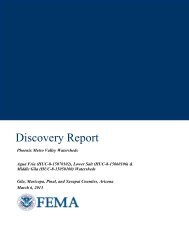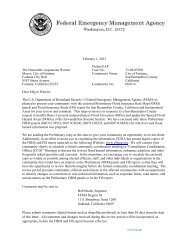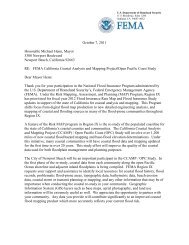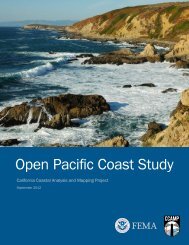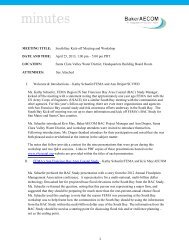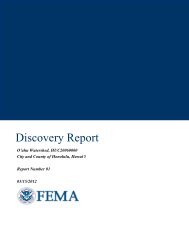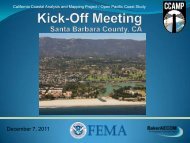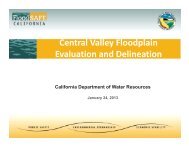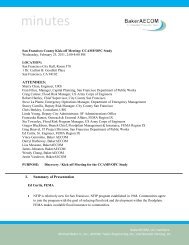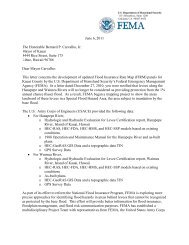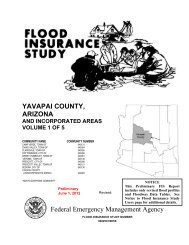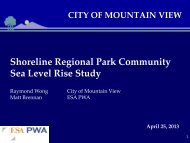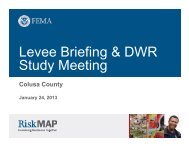Final Guam Discovery Report - FEMA Region 9
Final Guam Discovery Report - FEMA Region 9
Final Guam Discovery Report - FEMA Region 9
- No tags were found...
Create successful ePaper yourself
Turn your PDF publications into a flip-book with our unique Google optimized e-Paper software.
<strong>Discovery</strong> <strong>Report</strong><strong>Guam</strong> Watershed, HUC8 30010000Island of <strong>Guam</strong><strong>Report</strong> Number 0108/17/2012
Table of ContentsI. General Information ............................................................................................. 1II. Watershed Stakeholder Coordination .................................................................. 3III. Data Analysis ....................................................................................................... 3A. Data That Can Be Used for Flood Risk Products ................................................ 51. Topographic Data ................................................................................................. 52. Building Stock ...................................................................................................... 5B. Other Data and Information ................................................................................. 61. Mitigation Plans/Status, Mitigation Projects ....................................................... 62. National Flood Insurance Program Mapping Study Needs ................................. 63. Socio-Economic Analysis .................................................................................... 64. Community Rating System .................................................................................. 65. Flood Control Structures ...................................................................................... 7i. Levees .................................................................................................................. 7ii. Dams .................................................................................................................... 76. SFHA Management/Community Assistance Visits ............................................. 77. Regulatory Mapping ............................................................................................ 78. Watershed Projects ............................................................................................... 8i. Ongoing Projects .................................................................................................. 8ii. Completed Projects .............................................................................................. 89. Other Data ............................................................................................................ 9IV. <strong>Discovery</strong> Meeting ............................................................................................. 10V. Findings and Options ......................................................................................... 10References ............................................................................................................................ 14Appendixi
I. General InformationWithin the Federal Emergency Management Agency’s (<strong>FEMA</strong>) Risk Mapping, Assessment,and Planning (Risk MAP) Program, the <strong>Discovery</strong> process initiates watershed-widediscussions about increasing resilience to flooding. <strong>FEMA</strong> partners with local and regionalofficials during <strong>Discovery</strong> to gather and validate available flood data as well as discuss floodhistory, areas at risk for flood loss, development plans, adequacy of existing hazard data,mapping needs, community activities that relate to flood risk, and solutions for reducing thatrisk. The goal of <strong>Discovery</strong> is to determine which areas within a watershed require mapping,risk assessment, or mitigation planning assistance.Because flood hazards change over time, <strong>Discovery</strong> provides an opportunity to take acomprehensive look at the components and activities that contribute to flood risk. Localparticipation in this process will increase understanding of flood risk and help identifyproactive steps that can be taken to protect communities from loss of life and propertydamage related to flooding. Through Risk MAP, <strong>FEMA</strong> can provide information to improverisk communication and enhance local mitigation plans, resulting in decreased flood risk.As part of the <strong>Discovery</strong> process, <strong>FEMA</strong> holds a <strong>Discovery</strong> Meeting to review the flood riskdata that was collected, discuss the community’s flooding history, development plan, floodrisk concerns, stormwater and Special Flood Hazard Area (SFHA) management activities,and other daily operations that affect flood risk. The <strong>Discovery</strong> Meeting for the Island of<strong>Guam</strong> Watershed was held on June 1, 2012.This report, along with the <strong>Discovery</strong> Map, summarizes the information gathered as part ofthe <strong>Discovery</strong> process for the Island of <strong>Guam</strong> Watershed (HUC 8 – 30010000).The Island of <strong>Guam</strong> is the largest and southernmost island of the Mariana Islandsarchipelago. <strong>Guam</strong> is approximately 6,000 miles west of San Francisco; 3,700 miles westsouthwestof Honolulu; 1,500 miles east of Manila; 2,100 miles southeast of Hong Kong;3,100 miles northwest of Sydney; and 1,500 miles southeast of Tokyo. It has an area ofapproximately 209 square miles, approximately 100 miles of coastline, and is divided into 19watersheds. Five watersheds lie in the limestone formation of northern <strong>Guam</strong> and fourteenare in the volcanic rock terrain of southern <strong>Guam</strong>. These watersheds along with roadwaysare shown on the Watershed Locator Map.1
Watershed Locator Map: Island of <strong>Guam</strong>NATIONAL FLOODINSURANCE PROGRAMWDM<strong>Guam</strong>Watershed AffectsCOMMUNITIES:ISLAND OF GUAMWATERSHED DISCOVERY MAPMap Symbology^_ Capital of <strong>Guam</strong>HUC-8 Code30010000RELEASE DATE8/17/2012ApraTaelayagCettiUV 9DEDEDO VILLAGEUV UV 34 28UV 29UV 27AUV UV 16 26UV 8 UV 10UV 32UV 5UV 3TAMUNINGUVVILLAGE27UVUV UV 10A15Agana30AGANAUVVILLAGEAGANA HEIGHTSUV 41MANGILAO(PAASAN) VILLAGE7 UVVILLAGEUV 7A BARRIGADAMONGMONG TOTO11 UV VILLAGE^_^_^_6 UV 24 MAITE VILLAGEASANUVVILLAGEPITISINAJANAUV 151 VILLAGEVILLAGEPagoUV 2A YONA VILLAGEAgatUV 12YligUV SANTA RITA 17VILLAGETalofofoUV 4AAGATVILLAGETALOFOFO VILLAGEUV 2UgumUV 3AUV 14 UV 3UV 3AYIGO VILLAGE/0 12,500 25,000 50,000 FeetWATERSHED LOCATOR-ISLAND OF GUAMP h i l i p p i n e S e aMajor RoadwaysUmatacUMATACVILLAGEINARAJAN VILLAGEMalojlojStreamsToguanGeusInarajanS o u t h P a c i f i c O c e a nWatershed BoundaryMERIZOVILLAGEVillagesManellUV 4
II.Watershed Stakeholder CoordinationThe project team compiled a stakeholder list for the Island of <strong>Guam</strong> using online resources.Major stakeholders revised this list before finalization by the project team. A list of thecontacts made during this effort is included in the Appendix to this document.III.Data AnalysisA list of the data collected prior to the <strong>Discovery</strong> meeting, the deliverable or product inwhich the data are presented, and the source of the data is shown in Table 1 below. ThisData Analysis section is further divided into two sections: one section listing the data thatcan be used for Risk MAP products (regulatory and non-regulatory), and one listing theother data and information that helped the project team form a more holistic understandingof the Island of <strong>Guam</strong> Watershed.Table 1: Data Collection for <strong>Guam</strong> WatershedData Types Deliverable/Product SourceCommunity AssistanceVisitsCommunity Fact Sheet Community InformationSystem (CIS)Community RatingSystemCommunity Fact Sheet3<strong>FEMA</strong>’s “CommunityRating SystemCommunities and TheirClasses”Demographics, Industry Community Fact Sheet US Census Bureau,QuickFacts and AmericanFactFinderInsurance Policies Community Fact Sheet Community InformationSystemMitigation Plans Status Community Fact Sheet <strong>FEMA</strong> <strong>Region</strong>al OfficeMitigation Projects Community Fact Sheet Data.gov: <strong>FEMA</strong> HazardMitigation ProgramSummaryRepetitive Loss Community Fact Sheet Community InformationSystemZone B, C, and X Claims Community Fact Sheet Community InformationSystemLetter of Map Change(LOMCs)Community Fact SheetCommunity InformationSystemDeclared Disasters Community Fact Sheet Data.gov: <strong>FEMA</strong> DisasterDeclarations SummaryHazards Community Fact Sheet Community InformationSystem
Table 1: Data Collection for <strong>Guam</strong> Watershed (Continued)Data Types Deliverable/Product SourceBoundaries: Villages,<strong>Guam</strong><strong>Discovery</strong> Map Geodatabase <strong>FEMA</strong> Effective DFIRMdatabase (September 28,Boundaries: County andState<strong>Discovery</strong> Map Geodatabase2007)<strong>FEMA</strong> Effective DFIRMdatabase (September 28,2007)Boundaries: Watersheds <strong>Discovery</strong> Map Geodatabase Natural Resources Atlas ofSouthern <strong>Guam</strong>; Universityof <strong>Guam</strong>’s Water andEnvironmental ResearchInstitute (WERI)Effective Flood Zones:Modernized SFHAsFuture or recent highwayimprovement, bridge,culvert, levee locations<strong>Discovery</strong> Map Geodatabase<strong>Discovery</strong> Map Geodatabase<strong>FEMA</strong> Effective DFIRMdatabase (September 28,2007)Information based on <strong>Final</strong>Environmental ImpactStatement for <strong>Guam</strong> andCNMI Military Relocation(June 2010)Hydrography: <strong>Guam</strong> <strong>Discovery</strong> Map Geodatabase <strong>FEMA</strong> Effective DFIRMdatabase (September 28,2007)Mitigation Projects:Recent, ongoing, planned,desired <strong>FEMA</strong>/OFA/localprojectsRecently developed orplanned high growth areas<strong>Discovery</strong> Map Geodatabase<strong>Discovery</strong> Map GeodatabaseDeveloped based oncommunity interviewDeveloped based oncommunity interview &<strong>Final</strong> EnvironmentalImpact Statement for<strong>Guam</strong> and CNMI MilitaryRelocation (June 2010)Stream Gages <strong>Discovery</strong> Map Geodatabase US Geologic SurveyStudy Needs: <strong>FEMA</strong> <strong>Discovery</strong> Map Geodatabase Coordinated NeedsManagement SystemStudy Needs: Recent,ongoing, planned, desired<strong>FEMA</strong>/OFA/local studies<strong>Discovery</strong> Map GeodatabaseDeveloped based oncommunity interview &<strong>Final</strong> EnvironmentalImpact Statement for<strong>Guam</strong> and CNMI MilitaryRelocation (June 2010)4
Table 1: Data Collection for <strong>Guam</strong> Watershed (Continued)Data Types Deliverable/Product SourceTopographic Availability <strong>Discovery</strong> Map Geodatabase 2007 Joint AirborneLiDAR BathymetryTechnical Center ofExpertise (JALBTCX)Topobathy LiDAR: <strong>Guam</strong>Transportation: Railroads,<strong>Guam</strong>Transportation: Roads,<strong>Guam</strong><strong>Discovery</strong> Map Geodatabase<strong>Discovery</strong> Map GeodatabaseBureau of Statistics andPlans, Government of<strong>Guam</strong>Bureau of Statistics andPlans, Government of<strong>Guam</strong>Historic Sites <strong>Discovery</strong> Map Geodatabase Bureau of Statistics andPlans,Government of <strong>Guam</strong>Contacts Excel Spreadsheet Local websitesA. Data That Can Be Used for Flood Risk Products1. Topographic DataAs shown on the <strong>Final</strong> <strong>Discovery</strong> Map, Light Detection and Ranging (LiDAR) data isavailable for the entire Island of <strong>Guam</strong>. This 2007 Joint Airborne LiDAR BathymetryTechnical Center of Expertise (JALBTCX) Topobathy LiDAR data were collectedusing the Compact Hydrographic Airborne Rapid Total Survey (CHARTS) system forthe Government of <strong>Guam</strong> Department of Public Works and the Office of HomelandSecurity from February 18 through May 20, 2007. This 2007 dataset was collectedacross the Island of <strong>Guam</strong> to produce 2-foot contours and bathymetric LiDAR wascollected to fill the areas where no data were obtained during previous survey efforts.The accuracy of this data is listed below in Table 2.2. Building Stock<strong>Guam</strong>’s current hazard mitigation plan states that no new building stock was addedduring this update. The building stock referenced by this plan is from the 2008 updateand contains approximately 40,000 buildings, both residential and non-residentialstructures. This data is to be expanded upon in future updates to possibly includebuilding type, age, material and prior hazard damage.Table 2: Topographic DataData Type Title AccuracyTopography: LiDAR 2007 JALBTCX TopobathyLiDAR: <strong>Guam</strong>Horizontal: +/-3 mVertical: +/-15 cm5
B. Other Data and Information1. Mitigation Plans/Status, Mitigation Projects<strong>Guam</strong> currently has a hazard mitigation plan that was published in 2011. This plan wasprepared by URS Group, Inc. and approved by <strong>FEMA</strong> in April 2011. It describes theplanning process for identifying hazards and risk and vulnerabilities associated withthose hazards. This plan also identifies and prioritizes mitigation actions andencourages the development of local mitigation projects. One of the prioritizedprojects that is related to flood risk and is estimated to be completed in the next 2 yearsis to create a comprehensive inventory of all essential facilities that are at risk fromhazards.2. National Flood Insurance Program Mapping Study NeedsComparing the Letter of Map Change (LOMC) list from <strong>FEMA</strong> to the LOMC table inthe effective Flood Insurance Study (FIS) identifies that there are no all relevant Lettersof Map Revision (LOMR) have been incorporated into the effective study.The Coordinated Needs Management Strategy (CNMS) is <strong>FEMA</strong>’s strategy forcoordinating the management of mapping needs using modern geospatial technologiesand current policies, requirements, and procedures. CNMS uses existing digital mapdata to inventory and manage flood map update issues and support Flood InsuranceRate Map (FIRM) revision and production planning activities. Currently, the Island of<strong>Guam</strong> has no requests identified in CNMS.3. Socio-Economic AnalysisAccording to the 2010 Census, <strong>Guam</strong> has a population of 159,358. This is an increaseof 2.9% from the 2000 Census. Data and statistics from the 2000 US Census wereutilized for this research because the 2010 demographic profile data will not beavailable until later in 2012. The median age in the watershed is 27.4, with 5.3% of thepopulation over 65 years old. The population of <strong>Guam</strong> is diverse with people of NativeHawaiian and Other Pacific Islander races making up 49.0%. Asians comprise thesecond-largest population group at 33.0%, and Caucasians comprise 6.9% of thepopulation. As of 2000, just under 37% of civilians over the age of 16 that desiredemployment were working, with a median household income of just over $20,000annually. Residents across <strong>Guam</strong> worked primarily in arts, entertainment, recreation,accommodation, and food services; education, health and social services; retail trade;public administration; and construction. No specific demographics data indicatesspecial outreach strategies are necessary for the residents in <strong>Guam</strong>.4. Community Rating SystemThe Community Rating System (CRS) is a voluntary program created under the NFIPto reduce flood damages to insurable property, strengthen and support the insuranceaspects of the NFIP, and encourage a comprehensive approach to SFHA management.Currently, <strong>Guam</strong> is not in the CRS program.6
5. Flood Control Structuresi. LeveesThere are no levees identified in <strong>FEMA</strong>’s Mid-Term Levee Inventory (MLI) nor inthe USACE National Levee Database (NLD). However, there is a levee identifiedon <strong>FEMA</strong>’s FIRM panel 131D. It is an earthen levee along the right overbank ofthe Namo River and was constructed as part of the USACE Namo River FloodControl Project. This levee lies within a Zone A SFHA and is not accredited by<strong>FEMA</strong>.ii. DamsFena Valley Reservoir was constructed in 1951 by the U.S. Navy to provide adependable water-supply for Navy personnel and civilians. The total storagecapacity of the Fena Valley Reservoir is approximately 7,180 acre-feet. It islocated in south-central <strong>Guam</strong> and is the major source of domestic water supply forsouthern <strong>Guam</strong>. The Fena Dam, located in the northwest portion of the reservoir,has a spillway altitude of about 111 feet. It is 85 feet in height, and 1,050 feet inlength.There are numerous watershed structures located on the Island of <strong>Guam</strong> that werebuilt by the Department of Defense both pre and post war. As feasible, thesehistoric sites were located and shown on the <strong>Discovery</strong> Map.6. SFHA Management/Community Assistance Visits<strong>FEMA</strong>’s Community Information System (CIS) is a database that serves as an officialrecord of the NFIP information. This database provides information about SFHAmanagement, mapping, and insurance for the communities that participate in the NFIP.Data collected from the CIS indicates that the most recent Community Assistance Visit(CAV) occurred on April 26, 2006. A CAV is a visit to the community by <strong>FEMA</strong> staff,or staff of a State agency on behalf of <strong>FEMA</strong> that provides technical assistance to thecommunity and assures that the community is adequately enforcing its SFHAmanagement regulations. The findings from this visit indicated minor problems withthe <strong>Guam</strong>’s SFHA floodplain management regulations. However, there were seriousproblems with community administration and enforcement procedures as well asengineering problems with the Flood Insurance Study maps. As a result of this CAV,<strong>Guam</strong> took action to improve their NFIP compliance oversights and corrected manypast NFIP violations. <strong>Guam</strong> was taken off probation, which became effective April 6,1992, on April 6, 2008.7. Regulatory MappingThe most recent FIRM update for <strong>Guam</strong> became effective September 28, 2007.According to the FIS, this revision incorporated a hydrology and hydraulic study forthe Agana River, modified several transects along the southern coast as part of therevised typhoon analysis, and decreased the effective floodway along the Geus Riverand Unnamed Streams 1M and 2M.7
8. Watershed Projectsi. Ongoing ProjectsNOAA Coastal Services Center is currently developing sea level rise and coastalinundation maps for <strong>Guam</strong>. Once these maps are complete, they will beincorporated into the datasets available through the Center’s Sea Level Rise andCoastal Flooding Impacts Viewer. This Viewer can be accessed through the DigitalCoast website (http://www.csc.noaa.gov/digitalcoast/tools/slrviewer/index.html).The sea level rise data, maps and information provided in the viewer should only beused as a screening-level tool and is estimated to be completed in early 2013. Thedata in these maps do not consider natural processes such as erosion, subsidence, orfuture construction. The inundation will be shown as it would appear during meanhigher high water (MHHW) conditions.The Pacific Marine Environmental Lab (PMEL) modeling results conducted in thecomprehensive tsunami hazard assessment for <strong>Guam</strong>, described below, were usedto create tsunami evacuation zones. These are currently in draft format and underreview. The final evacuation zones should be available in the near future.ii. Completed ProjectsThe NOAA Center for Tsunami Research teamed with the Pacific RiskManagement ‘Ohana (PRiMO) to conduct a comprehensive tsunami hazardassessment for <strong>Guam</strong>. For this study, five coastal communities (Tumon Bay,Agana Bay, Pago Bay, Apra Harbor, and Inarajan Bay) on the Island of <strong>Guam</strong> wereanalyzed with both moderate (Mw 8.5) and Great Earthquake (Mw > 9.0)scenarios. This hazard assessment was completed in May 2010 and includesearthquake source identification and resulting tsunamis generated that would havethe greatest impact on the Island of <strong>Guam</strong>, its population, and economy.Historically, <strong>Guam</strong> has been considered to be at relatively low-risk to tsunamis dueto the island’s steep topography and lack of significant continental shelf. However,this study suggests that features surrounding <strong>Guam</strong> do not offer “protection” fromtsunamis as originally assumed. Furthermore, the study emphasizes that moderateearthquake scenarios could pose an extreme hazard along localized portions of the<strong>Guam</strong> coastline.A <strong>Final</strong> Environmental Impact Statement (EIS) finalized in July 2010, wasprepared for the proposed military buildup that is scheduled to occur through 2020.The buildup program is a result of the United State defense posture in the Pacificregion and of an alliance with Japan. The relocation of Marines from Japan isscheduled to occur during the same timeframe as the wharf construction for theNavy transiting nuclear aircraft carriers and <strong>Guam</strong>’s proposed Army Air andMissile Defense Task Force. These three actions, known as the <strong>Guam</strong> and theCommonwealth of the Northern Mariana Islands (CNMI) military relocation, areprojected to increase <strong>Guam</strong>’s population by approximately 30,000 individuals.8
This <strong>Final</strong> EIS evaluates these actions along with the proposed infrastructurechanges that will need to occur.9. Other DataThe USGS provided analysis of rainfall and resulting flooding on <strong>Guam</strong> in a fact sheettitled “Flooding Associated with Typhoon Chata’an, July 5, 2002, <strong>Guam</strong>.” Thesouthern half of the eye of Typhoon Chata’an moved over the northern portion of theisland. Rainfall exceeded 21 inches over mountainous areas of south-central <strong>Guam</strong> andthe extreme rainfall led to flooding in southern <strong>Guam</strong>. The fact sheet provides rainfallgage data for 12 stations and associated peak flows and stages at 16 USGS streamflowgagingstations. The typhoon resulted in new peak stage records at many locations(located on a map included in the fact sheet). Previous records are also identified in thefact sheet. In addition, the fact sheet provides flood recurrence interval computations.The <strong>Guam</strong> Transportation Stormwater Drainage Manual was created to provideplanning and design guidelines for stormwater management facilities for transportationprojects on the Island of <strong>Guam</strong>. The goal of this manual is to mitigate the effects ofhydrologic change and water quality degradation that can occur from development.This manual was finalized in August 2010.Parsons prepared the Draft Storm Water Implementation Plan for the <strong>Guam</strong> RoadNetwork (GRN) as part of the development of the Transportation Storm WaterDrainage Manual 1 (TSDM) and the Storm Water Drainage Master Plan developmentfor the <strong>Guam</strong> Department of Public Works. The Storm Water Implementation Plan forthe GRN (Plan) provides source control and treatment control best managementpractices (BMPs) to be used for the various GRN projects. This Plan includes asuite of treatment BMPs that can be used throughout the GRN. BMP selection,discussed herein, considers pollutants of concern, right of way constraints,maintainability, existing drainage infrastructure, proximity to wetlands, as well asexisting treatment devices.In April 2010, a final report titled “Understanding the Role of Typhoons, Fire, andClimate on the Vegetation Dynamics of Tropical Dry Forests: Looking to the Past toDevelop Future Management Solutions” summarized the results of a study that wasconducted in the Cocos Lagoon on the southern coast of <strong>Guam</strong>. One of the collectionsites for this study was on the northeast part of the lagoon at the mouth of the GeusRiver. Results at this site suggest that the layers were likely laid down during typhoonstrikes that also resulted in significant rainfall and flooding in the Geus Riverwatershed. Follow up work was proposed to further investigate the impact typhoons,fire and the climate have on the Island of <strong>Guam</strong>.The Bureau of Reclamation <strong>Guam</strong> Study Office created a Planning Aid Document for“Potential Water Resources Development” on the Island of <strong>Guam</strong> in March 1984. Thisdocument identifies potential sites for impoundment structures in order to help solve9
<strong>Guam</strong>’s water resources problems and needs. Public comments on the direction of thisstudy were requested.The CNMI and <strong>Guam</strong> Stormwater Management Manual, completed in October 2006by the CNMI Division of Environmental Quality (DEQ) and the <strong>Guam</strong> EnvironmentalProtection Agency (GEPA), was developed to provide the framework to ensure theeffective implementation of stormwater management practices and to provide designguidance on the most effective BMPs for new development both during and postconstruction in <strong>Guam</strong>. This manual is divided into two volumes. Volume I providesan overview on local stormwater issues and how to size and design BMPs whileVolume II provides more detailed information on how to select and locate BMPs.<strong>Guam</strong> Soil Erosion and Sediment Control Regulations, originally adopted in 1985,were revised in April 2000. These regulations are again under revision to includestormwater management in order to protect the waters of <strong>Guam</strong> from the adverseimpacts of urban stormwater runoff.IV.<strong>Discovery</strong> MeetingA <strong>Discovery</strong> meeting was held for the Island of <strong>Guam</strong> Watershed via WebEx on June 1,2012. Representatives from the <strong>Guam</strong> Homeland Security/Office of Civil Defense, <strong>Guam</strong>Bureau of Statistics and Plans (BSP), <strong>Guam</strong> Department of Land Management (DLM),<strong>Guam</strong> Environmental Protection Agency (EPA), United States Geological Survey (USGS),National Weather Service (NWS), the United States Department of Agriculture/NaturalResource Conservation Service (USDA/NRCS), the American Red Cross, BakerAECOM,and <strong>FEMA</strong> <strong>Region</strong> IX attended the meeting. Sign in sheets and meeting notes from the<strong>Discovery</strong> Meeting are provided in the Appendix. Draft <strong>Discovery</strong> <strong>Report</strong> comments havealso been included in the Appendix.V. Findings and OptionsThe <strong>Discovery</strong> process has identified several priority restudy needs in the <strong>Guam</strong> Watershed.These engineering analyses are listed below in Table 3 and, if funded and performed, shouldbe used to update the FIS and FIRM for the Island of <strong>Guam</strong>. In addition, <strong>FEMA</strong>’s tool fortracking study accuracy, CNMS, will be updated to reflect these needs. All recommendedprojects are identified below on the <strong>Final</strong> <strong>Discovery</strong> Map.The following study/project was identified as high priority. An explanation as to why thiswas ranked as high priority is provided below.Island of <strong>Guam</strong> DFIRM Update – In 2007, LiDAR data was collected for the Governmentof <strong>Guam</strong> Department of Public Works and the Government of <strong>Guam</strong> Office of HomelandSecurity. This data should be used to update the SFHAs for the Island of <strong>Guam</strong>. Thetopography that many of these streams were originally mapped on is more than 50 years10
old. Concern has also been expressed by the community that during the digital conversionof the FIRMs some areas were removed from the SFHAs.The medium priority projects, identified below, provide further explanation for their ranking.Coastal inundation - NOAA Coastal Services Center is currently developing coastalinundation maps for <strong>Guam</strong>. These could be incorporated into non-regulatory productsonce this study is complete. Scheduled completion is 2013. This project could become ahigh priority project if funding is available.Flood Risk Assessment – A flood risk assessment dataset should be created to include theupdated DFIRM results as well as any additional study results conducted. This analysis, ata minimum, should include a loss analysis for new or updated flood study reaches. Oncethe losses are identified using Hazards-United States (Hazus), a nationally standardizedmethodology which contains models for estimating potential losses from earthquakes,floods, and hurricanes, the annualized calculations will need to be calculated outside ofHazus unless this software is modified to allow annualized calculations using user supplieddata. Any other available data, including locally supplied general building stock (update iscurrently underway), population data, property tax assessment (Department of Revenueand Taxation is currently reevaluating its property values) or user supplied depth grids(possibly from the coastal inundation study), should be included in this refined lossanalysis.Namo River – Namo River is located on the west side of <strong>Guam</strong>. The USACE constructeda flood control project along this stream in 1981, however, this stream was never modeledas a detailed stream. This stream should be modeled as a detailed study to incorporate thetrapezoidal channel on the downstream section and the earthen levee along the rightoverbank, which was also part of this USACE project. According to the 2011 <strong>Guam</strong>Hazard Mitigation Plan, five of the 14 repetitive loss properties for the entire island liewithin this watershed. It is not certain that these lie along the Namo River however, threeof the five lie within a SFHA. Due to the reasons stated above, as well as the fact that theeffective study is approximately 30 years old, this project was ranked as a medium priority.The low priority project identified in the table below is to incorporate the ongoingNOAA/PMEL tsunami inundation modeling into the FIS and FIRMs. This was assigned alow priority due to the lack of information available regarding the project’s schedule.11
Table 3: Recommended ProjectsReach Watershed Need PriorityIslandwide Islandwide Update DFIRMs using High2007 JALBTCXTopobathy LiDARCoastal Inundation Various Coastal inundation MediummappingFlood Risk Assessment Various Refined loss analysis MediumNamo River from Agat Bayupstream approximately 1.3 milesAgat New detailed riverinestudy (hydrology andMediumNOAA/PMEL tsunamiinundation modeling projectVarioushydraulics)New tsunamiinundationmodeling/mappingLowAs a result of this <strong>Discovery</strong> project, any one of these projects could be selected for <strong>Guam</strong>once funding becomes available.12
<strong>Discovery</strong> Map: Island of <strong>Guam</strong>FLOOD RISK ASSESSMENT DATASETMEDIUM PRIORITY") 3")3Ah#") 9COASTAL INUNDATIONMEDIUM PRIORITYA flood risk assessment dataset should be created to include updated DFIRM resultsas well as any additional study results collected. Minimally, this dataset should includea loss analysis for new or updated study reaches.####NOAA Coastal Services Center is currently developing coastalinundation maps for <strong>Guam</strong>. These should be incorporated intothe DFIRMs once this study is complete. Scheduled completionis early 2013.NAMO RIVERMEDIUM PRIORITYThe USACE constructed a flood control project alongthis stream in 1981, however, this stream was nevermodeled as a detailed stream. This stream should bemodeled as a detailed study to incorporate the trapezoidalchannel on the downstream section and the earthenlevee along the right overbank which was also part of thisUSACE project. Due to the reasons stated above, as wellas the fact that the effective study is approximately 30 yearsold, this project was ranked as a medium priority.hhApraTaleyfac RiverTaelayag CreekDededo") 28#Yigo #") 34 ") 3 ") 29### # #") ") # #") 1") 15##")h h#hhh ##") ") ")###")") 14 1 h") 10A")") 14B ")") 14 26##### h #h ")h")h ") ") 15") 1") 7 ") 33 ") 33 # ") # #Agana8 ! hMangilao# # #") 11 #####")") 18 ") ") 106hh") ###") 1 ") 10Pago")") 4h#")") 2A 5 ##")#") ") 52 Agat## # #") 12 YligISLANDHIGHDFIRM#OF GUAM UPDATEPRIORITYh") 17Fena Valley") 4AReservoir Dam") 4Talofofo# #hh") 2CettiUgumUmatacMalojlojh # h") 4#UmatacLiDAR data was collected for the Government of <strong>Guam</strong> Department of Public Worksand the Government of <strong>Guam</strong> Office of Homeland Security. Since the topographyToguan#that many of these streams were originally mapped on is more than 50 years old, thisdata should be used to update the SFHAs for the Island of <strong>Guam</strong>. The community#has also expressed concern that during the digital conversion of the FIRMs, someareas were removed from the SFHAs.#Inarajan # hFinile CreekSella RiverSalinas RiverGaan RiverChaligan CreekPagachao CreekNamo RiverTaelayagAscolasito CreekAga RiverAsmafines RiverCetti RiverTogcha RiverUmatac RiverPigua RiverLaelae RiverBile RiverBonya RiverSan Nicolas RiverToguan RiverGeusLaguas RiverAguada RiverGautali RiverMaulap RiverSadog Gago RiverPajon RiverGeus RiverBig Gautali RiverAstaban RiverTenjo RiverAtantano RiverAlmagosa RiverAplacho RiverBubulao RiverTaguag RiverMasso RiverSasa RiverPaulana RiverIeygo RiverDante RiverMaemong RiverAjayan RiverTalisay RiverMaigue RiverAgfayan RiverYlig RiverPasamano RiverCalacag RiverBonya RiverUgum RiverLonfit RiverMalaja RiverYledigao RiverFonte RiverTarzan RiverMahlac RiverMaagas RiverSarasa RiverFintasa RiverSagge RiverLaolao RiverFensol RiverSiuga RiverManengon River RoadInarajan RiverYligRoadYlig RiverTogcha RiverYlig River RoadTalofofo RiverAsalonso RiverTinago RiverAgana RiverPago RiverTamuning DrainagewayChaot RiverManell RiverManellSuyafe RiverSumay River") 4Asgado CreekTongan Creek*LiDAR coverage is available for the entire Island¯MAP SYMBOLOGYBase Data!(CitiesBridgeRoadsMajor HighwaysWatershedsUSGS Stream Gageh Historic Structures/SitesDamsFlood DataShaded Zone XZone AZone AEZone AHZone AOZone DZone VE*from September 28, 2007 <strong>FEMA</strong> effective DFIRM databaseAreas of Mitigation InterestCritical Facilities# Public Schools# Fire Stations# Hospitals & Clinics# Police StationNATIONAL FLOODINSURANCE PROGRAMWDM<strong>Guam</strong>Watershed AffectsCOMMUNITIES:ISLAND OF GUAMWATERSHED DISCOVERY MAPHUC-8 Code30010000RELEASE DATE8/17/2012
ReferencesBureau of Reclamation. Planning Aid Document. Potential Water Resources Development<strong>Guam</strong>. March 1984.Department of Navy. <strong>Final</strong> Environmental Impact Statement <strong>Guam</strong> and CNMI MilitaryRelocation. July 2010.Donnelly, PhD, Jeffrey P. Understanding the Role of Typhoons, Fire, and Climate on theVegetation Dynamics of Tropical Dry Forests: Looking to the Past to Develop FutureManagement Solutions. April 2010.Federal Emergency Management Agency. Flood Insurance Study, Territory of <strong>Guam</strong>.September 2007.Federal Emergency Management Agency. National Flood Insurance Program -Community Information System. Accessed on June 20, 2012Federal Emergency Management Agency. Disaster Declaration Summary. Available athttp://www.fema.gov/datasets/data.gov.<strong>FEMA</strong>Declarations.xls. Accessed on May 11,2012.<strong>Guam</strong> Department of Public Works. Draft Storm Water Implementation Plan For the<strong>Guam</strong> Road Network. http://www.coralreef.gov/transportation/guam.pdf. March 2010.<strong>Guam</strong> Department of Public Works. <strong>Guam</strong> Transportation Stormwater Drainage Manual.http://www.guamtransportationprogram.com/docs/2030-plan/storm-water-drainagemanual.pdf.August 2010.Horsley Witten Group, Inc. CNMI and <strong>Guam</strong> Stormwater Management Manual. October2006.National Oceanic Association Agency. Coastal Storms Program. Available athttp://www.csc.noaa.gov/csp/projects_pacificislands.html. Accessed on June 11, 2012.U.S. Census Bureau. 2010. State & County QuickFacts. Available athttp://2010.census.gov/news/xls/cb11cn179_guam.xls. Accessed on June 12, 2012.U.S. Census Bureau. 2000. American FactFinder, Available athttp://factfinder2.census.gov. Accessed on June 22, 2012.U.S. Army Corps of Engineers. National Levee Database. Available athttp://nld.usace.army.mil/egis/f?p=471:1:3713414905257342. Accessed on June 20,2012.14
Appendix
<strong>Region</strong> IX <strong>Discovery</strong> 2011: <strong>Guam</strong> WatershedFact Sheet: <strong>Guam</strong>, Island ofCID: 660001 FIS/FIRM: Effective Date: 9/28/2007Level of Study: DetailedLast Community Meeting: 7/20/2006LOMCs: 19 Last CAV/CAC Date: 4/26/2006CRS StatusDemographicsPopulation: 159,358Median Age:27.4 yearsElderly (65+): 5.3%Native: 49.0%IndustrialPopulation in labor force: 57,278Median Income: $20,000Top 5 Industries:Arts, entertainment, recreation, accommodation and food servicesEducation, health and social servicesRetail TradePublic AdministrationConstructionPresidentially‐Declared DisastersFlood‐related total: 1Recent flood related: July 2004Other Hazards:Typhoon, Earthquake, FireInsuranceTotal Premiums: $405,749 Variances: 0Total Coverage: $52,078,700 Repetitive Losses: 29Total Policies: 252 BCX Zone Claims: 4A Zone Policies: 193Mitigation Projects and Other GrantsPending Mitigation Project: Harden Generator Shelters ‐ Department of Corrections<strong>FEMA</strong> Funding: $ 74,000.00Local Cost‐Share: $‐Pending Mitigation Project:Southern District Tsunami Siren System ‐ Office of Civil Defense<strong>FEMA</strong> Funding: 90%Local Cost‐Share: 10%Pending Mitigation Project:Harden Generator ‐ Mayor's Office<strong>FEMA</strong> Funding: $ 20,000.00Local Cost‐Share: $‐Mitigation Plans:<strong>Guam</strong> Hazard Mitigation PlanEffective: April 2011Expires: April 2014Note: The demographic and industrial statistics provided above (except population) were obtained from the 2000 US Census. This data for the 2010Census should be available late 2012.
<strong>Guam</strong> <strong>Discovery</strong> Contact ListName Affiliation Address Phone Number EmailKathleen Dobler Natural Resources Conservation Service - Pacific Island AreaUSDA Natural Resources Conservation Service (NRCS) Pacific Islands Area State Office,P.O. Box 50004, Honolulu, HI 96850 808-541-2600 x 114 Kathleen.Dobler@hi.usda.govBart Lawrence Natural Resources Conservation Service - Pacific Island Area USDA/NRCS FHB Building, Suite 301, 400 Route 8, Mongmong, <strong>Guam</strong> 96910 671-300-8576 john.lawrence@pb.usda.govJackie Flores Natural Resources Conservation Service - Pacific Island Area USDA/NRCS FHB Building, Suite 301, 401 Route 8, Mongmong, <strong>Guam</strong> 96910 671-300-8578 jacqueline.flores@pb.usda.govJamie Carter NOAA - Pacific Services Center NOAA Pacific Services Center 737 Bishop Street, Suite 1550, Honolulu, HI 96813 808-227-2908 Jamie.Carter@noaa.govPenny Larin NOAA - Pacific Risk Management 'Ohana (PRiMO) NOAA Pacific Services Center 737 Bishop Street, Suite 1550, Honolulu, HI 96813 808-532-3973 Penny.Larin@noaa.govBen Reder NOAA - Pacific Services Center NOAA Pacific Services Center 737 Bishop Street, Suite 1550, Honolulu, HI 96813 808-525-3769 ben.reder@noaa.govChristin Reynolds NOAA - Pacific Risk Management 'Ohana (PRiMO) NOAA Pacific Services Center 737 Bishop Street, Suite 1550, Honolulu, HI 96813 808-532-3962 christin.reynolds@noaa.govMilton Yoshimoto USACE Honolulu District Bldg 230, Fort Shafter, HI 96858-5440 808-438-7009 milton.t.yoshimoto@usace.army.milDale Cox USGS Pacific Southwest Area Modoc Hall, USGS, 3020 State University Drive East, Sacramento, CA 95819 916-278-3033 dacox@usgs.govStephen Anthony USGS - Pacific Islands Water Science Center 677 Ala Moana Blvd., Suite 415, Honolulu, HI 96813 808-587-2400 x 2426 santhony@usgs.govSheri Schneider USGS - National Spatial Data Infrastructure Partnership Office 677 Ala Moana Blvd., Suite 415, Honolulu, HI 96813 503-310-1531 sschneid@usgs.govDerek Masaki USGS - National Spatial Data Infrastructure Partnership Office 677 Ala Moana Blvd., Suite 415, Honolulu, HI 96813 808-984-3721 dmasaki@usgs.govMichael Mann EPA U.S. EPA, <strong>Region</strong> 9, P.O. Box 50003, Honolulu, HI 96850 415-972-3505 mann.michael@epa.govRay Calvo <strong>Guam</strong> EPA P.O. Box 22439, GMF Barrigada, <strong>Guam</strong> 96913 671-475-1618 ray.calvo@epa.guam.govMargaret Aguilar <strong>Guam</strong> EPA P.O. Box 22439, GMF Barrigada, <strong>Guam</strong> 96913 671-475-1607 margaret.aguilar@epa.guam.govBenny Cruz <strong>Guam</strong> EPA, Water Resources Management Program P.O. Box 22439, GMF Barrigada, <strong>Guam</strong> 96913 671-475-1641 benny.cruz@epa.guam.govSusan Marquez <strong>Guam</strong> EPA, Water Resources Management Program P.O. Box 22439, GMF Barrigada, <strong>Guam</strong> 96913 671-475-1734 susan.marquez@guamepa.netElvis Ventura <strong>Guam</strong> EPA, Water Resources Management Program P.O. Box 22439, GMF Barrigada, <strong>Guam</strong> 96913 671-475-1631 elvis.ventura@epa.guam.govFrancis Mendiola <strong>Guam</strong> EPA, Water Resources Management Program P.O. Box 22439, GMF Barrigada, <strong>Guam</strong> 96913 671-475-1618 francis.mendiola@epa.guam.govMaricar Quezon <strong>Guam</strong> EPA, Water Pollution P.O. Box 22439, GMF Barrigada, <strong>Guam</strong> 96913 671-475-1601 maricar.quezon@epa.guam.govJoanne Brown <strong>Guam</strong> Department of Public Works 542 North Marine Drive, Tamuning, <strong>Guam</strong> 96913 671-646-3131 joanne.brown@dpw.guam.govJoe Guevara <strong>Guam</strong> Department of Public Works 542 North Marine Drive, Tamuning, <strong>Guam</strong> 96913 671-646-3104 joseph.guevara@dpw.govJesus Ninete <strong>Guam</strong> Department of Public Works P.O. Box 22439, GMF Barrigada, <strong>Guam</strong> 96913 671-646-3134 jesus.ninete@dpw.guam.govMarvin Aguilar <strong>Guam</strong> Department of Land Management, Planning Division P.O. Box 2950, Hagatna, <strong>Guam</strong> 96932 671-649-5263 x 300 marvin.aguilar@dlm.guam.govMonte Mafnas <strong>Guam</strong> Department of Land Management P.O. Box 2950, Hagatna, <strong>Guam</strong> 96932 671-649-5263 x 600 dlmdir@dlm.guam.govLeo Espia <strong>Guam</strong> Homeland Security, Office of Civil Defense 221B Chalan Palasyo, Agana Heights, <strong>Guam</strong> 96910 671-475-9600 leo.espia@ghs.guam.govPatrick Leon Guerrero <strong>Guam</strong> Homeland Security, Office of Civil Defense 221B Chalan Palasyo, Agana Heights, <strong>Guam</strong> 96910 671-475-9600 pat.leonguerrero@ghs.guam.govPilar Carbullido <strong>Guam</strong> Homeland Security, Office of Civil Defense 221B Chalan Palasyo, Agana Heights, <strong>Guam</strong> 96910 671-475-9600 pilar.carbullido@ghs.guam.govKenny Artero <strong>Guam</strong> Homeland Security, Office of Civil Defense 221B Chalan Palasyo, Agana Heights, <strong>Guam</strong> 96910 671-475-9600 ken.artero@ghs.guam.govJames McDonald <strong>Guam</strong> Homeland Security, Office of Civil Defense 221B Chalan Palasyo, Agana Heights, <strong>Guam</strong> 96910 671-475-9600 jim.mcdonald@ghs.guam.govVictor Torres <strong>Guam</strong> Bureau of Statistics and Plans P. O. Box 2950, Hagatna, <strong>Guam</strong> 96910 671-472-4201 victor.torres@bsp.guam.govEddie Baza Calvo Office of the Governor Ricardo J. Bordallo Governor's Complex, Adelup, <strong>Guam</strong> 96910 671-472-8931Gen Tamura <strong>FEMA</strong> 546 Bonney Loop, Bldg 520, Fort Shafter, HI 96858-5000 808-851-7917 gen.tamura@fema.dhs.govMichael Hornick <strong>FEMA</strong> 1111 Broadway, Suite 1200, Oakland, CA 94607 510-627-7260 michael.hornick@dhs.govEric Simmons <strong>FEMA</strong> 1111 Broadway, Suite 1200, Oakland, CA 94607 510-627-7029 eric.simmons@dhs.govJuliette Hayes <strong>FEMA</strong> 1111 Broadway, Suite 1200, Oakland, CA 94607 510-627-7211 juliette.hayes@fema.dhs.gov
DISCOVERY MEETINGATTENDANCE SHEETIsland of <strong>Guam</strong>June 1, 20129:00 AMNameStreet AddressCity, State, ZipAffiliation Phone Number Email Address1. James McDonald 221B Chalan PalasyoAgana Heights, <strong>Guam</strong> 969102. Leo Espia 221B Chalan PalasyoAgana Heights, <strong>Guam</strong> 969103. Pilar Carbullido 221B Chalan PalasyoAgana Heights, <strong>Guam</strong> 96910GHS/OCD ‐ HSA 671‐475‐9600 Jim.mcdonald@ghs.guam.govGHS/OCD – Acting Administrator 671‐475‐9600 Leo.espia@ghs.guam.govGHS/OCD – Chief Planner 671‐475‐9600 Pilar.carbullido@ghs.guam.gov4. Kenny Artero 221B Chalan PalasyoAgana Heights, <strong>Guam</strong> 96910GHS/OCD – Typhoon ProgramManager671‐475‐9600 Ken.artero@ghs.guam.gov5. Patrick LeonGuerrero221B Chalan PalasyoAgana Heights, <strong>Guam</strong> 96910GHS/OCD – Chief of Operations 671‐475‐9600 Pat.leonguerrero@ghs.guam.gov6. Chip Guard 3232 Hueneme RdBarrigada, <strong>Guam</strong> 96913NOAA/NWS 671‐472‐0946 Chip.guard@noaa.gov7. Penmer Gulac PO Box 2950Hagatna, <strong>Guam</strong> 96932Dept. of Land Management ‐Planner671‐649‐5390x352Penmer.gulac@dlm.guam.gov8. Paul Santos PO Box 2950Hagatna, <strong>Guam</strong> 96932Dept. of Land Management –Chief of Cadastre671‐649‐5263x292Paul.santos@dlm.guam.govSheet 1 of 3
18. Eric Simmons 1111 Broadway, Suite 1200Oakland, CA 9460719. Gen Tamura 546 Bonney Loop, Bldg 520Fort Shafter, HI 96858‐500020. Michael Hornick 1111 Broadway Suite 1200Oakland, CA 94607<strong>FEMA</strong> 510‐627‐7029 Eric.simmons@fema.dhs.gov<strong>FEMA</strong> 808‐851‐7917 Gen.tamura@fema.dhs.gov<strong>FEMA</strong> 510‐627‐7260 Michael.hornick@fema.dhs.gov21. StephanieThompson400 West 15 th St, Suite 500Austin, Texas 78701BakerAECOM ‐ GIS Analyst 512‐457‐7865 Stephanie.thompson@aecom.com22. April Smith 400 West 15 th St, Suite 500Austin, Texas 78701BakerAECOM ‐ Project Engineer 512‐457‐7818 April.smith@aecom.comPRIVACY ACT STATEMENT (5 U.S.C. 552(a) Privacy Act)a. AUTHORITY: 5 U.S.C. 301 Departmental Regulations;14 U.S.C.2; 14 U.S.C.5 (88); National Environmental Protection Act (NEPA), 42 U.S.C. 4321; 44U.S.C.3101b. PURPOSE: To obtain personal Information for the purpose of compiling mailing lists and to document public comments as required by the NEPA. NEPA requires public involvement inagency decision‐making processes. Decisional documents as well as comment mechanisms must be made available to the public.c. ROUTINE USES: To the Department of Homeland Security, U. S. Coast Guard, President of the Council on Environmental Quality, Environmental Protection Agency, and other authorizedfederal, state, or local governments who are authorized to develop and enforce environmental standards.d. DISCLOSURE: Disclosure of your name, street address, or other contact information is voluntary; however, if information is not provided, we may not be able to provide copies ofdecisional documents and to retrieve additional comments related to environmental impact actions or decisionsSheet 3 of 3
Project Name:Meeting:Date and Time:Island of <strong>Guam</strong><strong>Discovery</strong> MeetingJune 1, 2012 @ 9:00 AMPlace: WebEx Call‐in Number: 1‐866‐203‐6896 Conference Code: 6231479850<strong>Discovery</strong> Meeting Notes1. IntroductionsEric Simmons welcomed everyone to the meeting and introduced the team members. Meetingattendees included <strong>Guam</strong> Homeland Security/Office of Civil Defense, <strong>Guam</strong> Bureau of Statistics and Plans(BSP), <strong>Guam</strong> Department of Land Management (DLM), <strong>Guam</strong> EPA, United States Geological Survey(USGS), National Weather Service (NWS), the United States Department of Agriculture/Natural ResourceConservation Service (USDA/NRCS), the American Red Cross, and representatives from the FederalEmergency Management Agency (<strong>FEMA</strong>). A sign‐in sheet is provided as an attachment to these notes.2. Meeting Goals and ObjectivesThe June 1 st <strong>Discovery</strong> Meeting is an important step in the <strong>Discovery</strong> process under <strong>FEMA</strong>’s Risk MappingAssessment and Planning (RiskMAP) program. The goal of <strong>Discovery</strong> is for <strong>FEMA</strong> to work closely withlocal officials to better understand flood risk in order to prioritize possible projects identify areas at riskfor flood loss. Eric Simmons summarized the objectives of the meeting. These included:1. Introduce the National Flood Insurance Program (NFIP) and the Risk MAP Program2. Start a dialogue about the Island of <strong>Guam</strong>’s flood risk3. Communicate available resources4. Offer partnerships and answer questions5. Present the current status of the Island of <strong>Guam</strong>’s flood hazards and risk6. Learn about the Island of <strong>Guam</strong>’s needs, and prioritize areas needing a flood risk study3. Risk MAP Program OverviewEric Simmons described the Risk MAP program, giving details of the Risk MAP vision and the potentialbenefits of the program. This federal program is intended to assist with and fund mapping and riskprojects due to the typical lack of community funds to do so. Risk MAP primarily looks at floodinghazards (from tropical storms, heavy riverine rainfall, etc), but can include other hazard types such asearthquakes or hurricane winds, especially through risk assessment. Risk assessment can beaccomplished for typical flooding, earthquake and wind using <strong>FEMA</strong>’s HAZUS software . This tool is beingupdated to include tsunami hazards as well. <strong>FEMA</strong> currently does not evaluate future conditions basedon sea level rise nor coastal erosion. Headquarters is currently evaluating the future conditions effort.4. Flood Risk Assessment ProductsApril Smith discussed Risk MAP products and provided a comparison between regulatory and nonregulatoryproducts. She touched on the Flood Risk <strong>Report</strong>, Flood Risk Map, and the Flood Risk Database
which could include the following: Changes Since Last FIRM, Depth and Analysis Grids, Flood RiskAssessments and Areas of Mitigation Interest.5. <strong>Discovery</strong> ProcessEric Simmons described the <strong>Discovery</strong> process. He discussed <strong>FEMA</strong>’s desire to identify the unknownflood hazards and/or identify where flood risk products may be beneficial. If a specific area of concern ismentioned, then specific physical map revisions/areas of concern can be identified for potential projects.It is <strong>FEMA</strong>’s intent to work collaboratively with key stakeholders to identify Risk MAP projects.For the Island of <strong>Guam</strong>, we are in the beginning of this <strong>Discovery</strong> process, and are looking to localstakeholders for a better understanding of local needs. Once these needs are identified, <strong>FEMA</strong> willevaluate potential projects and document the evaluation results in a <strong>Discovery</strong> <strong>Report</strong> and Map.6. Discuss Flood Risk Data & <strong>Discovery</strong> MapApril Smith identified the 12 major federally declared disasters that have affected the Island of <strong>Guam</strong> inthe past 50 years. Stephanie Thompson continued with the island’s mapping history, and identifiedgeospatial data sources that have been collected to date. April Smith followed up with additional datathat has been collected, and talked about areas of concerns. All attendees were asked to mark up theirdiscussion maps to include known problem areas and to send them to <strong>FEMA</strong> and BakerAECOM so thatlocations of concern areas can be documented. Any additional information that would be helpful canalso be emailed for inclusion.The following additional data and data sources were identified:• 2007 LiDAR is available from either Vic Torres or from the NOAA Pacific Coast Office• Concern was also expressed that when the 2007 Effective DFIRMs were completed, some areaswere taken out of the special flood hazard areas, and they may need to be reevaluated.• The American Red Cross has helped residents within the last year with flooding and could be asource to document flooding locations.• NOAA is currently conducting sea level rise modeling. This should be complete by early nextyear.• NOAA conducted tsunami inundation mapping through the Marine Environmental Lab.• Local online newspapers could be a good source to document problem areas and local issuesduring high rainfall events• The Water and Environmental Research Institute of the Western Pacific (WERI) at the Universityof <strong>Guam</strong> is an excellent source of local studies and data.• USGS stream gages exist, which are funded by WERI. Data on these gages is available on theUSGS website if needed.• <strong>Final</strong> Environmental Impact Study (EIS) for the Military Buildup Program• The Villages of Piti and Asas were identified as as having critical flooding concerns during aWetlands Reserve Program stakeholders’ meeting. Flooding also occurs along the low lyingcoastal areas which wrap around the southeastern coast to Merizo.• <strong>Guam</strong> BSP is going to enter into a project with the USGS to update the GIS river file to meet theNational Hydrography Dataset (NHD) standard. This project should be completed May 2013.
• A number of pre‐war/post‐war dams are scattered across the south. WERI should be able toprovide more information on these.• Fena Valley Reservoir structure does have information available. This data can be obtainedeither through an advanced internet search or through a request to the BSP.• The Department of Public Works (DPW) recently adopted a storm water management plan whichdocuments drainage structures and similar facilities. BSP is still in the process of obtaining GISdata related to this document.• There are 8‐10 NRCS emergency watershed structures for mitigation purposes that have beeninstalled over the years, as well as the Talofofo watershed project that was conducted in the1990s.• A USGS report on dam sites throughout southern <strong>Guam</strong> should be available through WERI.• Following typhoons Pongsona and Chata’an, the University of <strong>Guam</strong> created numerous GISwatershed datasets that could be useful.• There are two USACE sponsored projects (one along the Namo River and the other somewhere inthe Agat area) that are available from Dan Meyers at Fort Shafter or BSP.• <strong>FEMA</strong> also has some post disaster damage assessments, including GIS data from Paka, Pongsonaand Chata’an.• <strong>FEMA</strong>, in partnership with the DLM, conducted a high water mark collection effort followingPongsona.• A USGS study on the <strong>Guam</strong> rainfall during Chata’an is available.7. Mitigation PlanningRisk MAP products could support the new mitigation plan that was approved in April 2011. Hazardmitigation grant programs were briefly discussed.We look forward to receiving any information that is available so that we can identify any needs thatwould benefit the local communities. All are looking forward to working together to promote mitigation,to be more resilient and to reduce future damage from disasters.
<strong>Discovery</strong> Project: <strong>Guam</strong>No. Date Received Commenter Commenter Title Description of Comment Data Submitted Additional Data Required Recommendation Summary Resolution1 7/15/2012 Bart Lawrence, USDA‐NRCSAssistant Director ‐ FieldOffice Operations (WesternPacific)Submitted Typhoons Fire Climate, 150‐BOR_DamSite<strong>Report</strong>,http://www.usace.army.mil/Portals/2/docs/civilworks/annual_report/fy08/POD_fy08b.pdf, andhttps://catalog.library.colostate.edu:444/search~S5?/dFlood+control+‐‐+Handbooks%2C+manuals%2C+etc./dflood+conThere are NO NRCS dams or structures on <strong>Guam</strong>. There are trol+handbooks+manuals+etc/‐3%2Cnumerousdam’s built by DOD pre‐post war, couple by the Japanese 1%2C0%2CB/frameset&FF=dflood+control+guaand others of unknown origin.m&1%2C1%2C documentsRevise text to accurately describewatershed structuresRevised text regarding DOD structures,incorporated Typhoons Fire Climate and 150‐BOR Dam Site <strong>Report</strong> documents. The USACEannual report document that was providedstrictly looked at annual dollars that had beenspent. No project specific details wereprovided, therefore this report was notincorporated. The other link provided was tothe Colorado State Library. This report waslisted there but was inaccessible. Documentwas searched for online but was not found andtherefore was not incorporated.2 8/6/2012 Ben RederGeospatial Analyst ‐ NOAAPacific Services Center1) Under the "Watershed Projects" heading, and regarding theNOAA PSC/PMEL tsunami inundation modeling.• The modeling has been completed (May 2010) and thus, is not anongoing project (The final report is actually referenced in the<strong>Discovery</strong> report as "The NOAA Center for Tsunami Researchteamed with PRiMO to conduct a comprehensive tsunami hazardassessment for <strong>Guam</strong>.") I think these are actually one and the samedocuments? I've attached the report so you can let me know if youare talking about something different....FYI We are however, stillworking with PMEL in doing a similar modeling exercise forSaipan/CNMI.• The PMEL modeling, plus other data, was used to create tsunamievacuation zones, which are currently in draft format and are underreview. The final evacuation zones should be available in the near Submitted PMEL_HazAssess.pdf documentfuture.(corrupt)2) Regarding the SLR Mapping:• We are working with SOEST at Univ. of Hawaii, and the mappingeffort should be completed early fall 2013.• The inundation zones are non‐regulatory and I wouldimagine...probably should not be included in DFIRMs? Unless<strong>Guam</strong> has opted to include "non‐regulatory" layers?• The SLR mapping will be included in a viewer (estimatedcompletion = early 2013).• The data in the maps do not consider natural processes such aserosion, subsidence, or future construction. Inundation is shown asit would appear during MHHW• The data, maps, and information provided in the viewer should beused only as a screening‐level tool.Revise text to incorporatecommentsRevise text to incorporatecommentsRevised text regarding the tsunami modelingRevised text regarding the sea level risemodeling project.3 8/10/2012 Maricar QuezonWater Pollution ControlProgram, <strong>Guam</strong> EPA1.) Please include <strong>Guam</strong> EPA, <strong>Guam</strong> CNMI StormwaterManagement Manual as one of the references or datas. The manualwas developed to provide framework to ensure the effectiveimplementation of stormwater management practices and designguidance on the most effective best management practices for newand post development in <strong>Guam</strong> for better water quality. This wasdeveloped October 2006. The <strong>Guam</strong> EPA is also currently revisingthe <strong>Guam</strong> Soil Erosion Control Regulations to include thestormwater management to protect the waters of <strong>Guam</strong> from theadverse impacts of urban stormwater runoff.<strong>Guam</strong> EPA, <strong>Guam</strong> CNMIStormwater Management Update text to incorporateManualcommentsIncorporated GEPA <strong>Guam</strong> CNMI StormwaterManagement ManualPage 1
No. Date Received Commenter Commenter Title Description of Comment Data Submitted Additional Data Required Recommendation Summary Resolution2.) The map does not reflect secondary road: namely Ylig andManenggon Rd.These two roads were added to the maphowever, not all secondary roads were addeddue to the scale of the map.4 8/13/2012 Vic TorresGIS Manager, Bureau ofStatistics and Plans3.) In the attendance sheet during the discovery meeting, pleasecorrect Maricar Quezon’s e‐mail address and contact no. intoMaricar.Quezon@epa.guam.gov with tel. no. 671‐47516011) Most especially conducting the high priority project to “Updatethe DFIRMS Using the 2007 Lidar Data”. The Bureau of Statisticsand Plans was the local agency technical lead on the 2007 <strong>Guam</strong>Lidar Survey project. We have also been encouraging <strong>FEMA</strong> toconduct such an update.Update text to incorporatecommentsUpdate text to incorporatecommentsUpdated attendance sheet.Confirmed that the report text represented thiscomment.2) As for the medium priority project Coastal Inundation projectdepending upon the results of the coastal inundation studyconducted by NOAA this could become a high priority project andmay need to occur as soon as possible after the high priorityproject based on funding availability.Update text to incorporatecommentsIncorporated text regarding the possibility ofthis project becoming a high priority project iffunding is available.3) The medium priority project Flood Risk Assessment project maybest be conducted when the Department of Revenue and Taxationfinishes its triennial real property tax assessment when propertyvalues will be re‐evaluated and when the building stock GIS layermay be updated by the conclusion of the project. That project iscurrently underway.Update text to incorporatecommentsIncorporated ongoing tax assessment andbuilding stock informationPage 2




